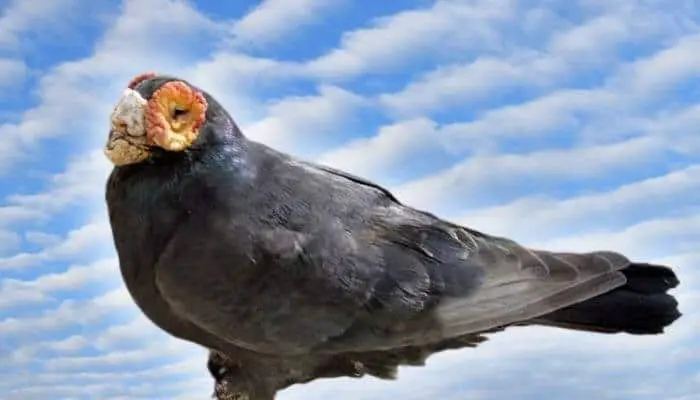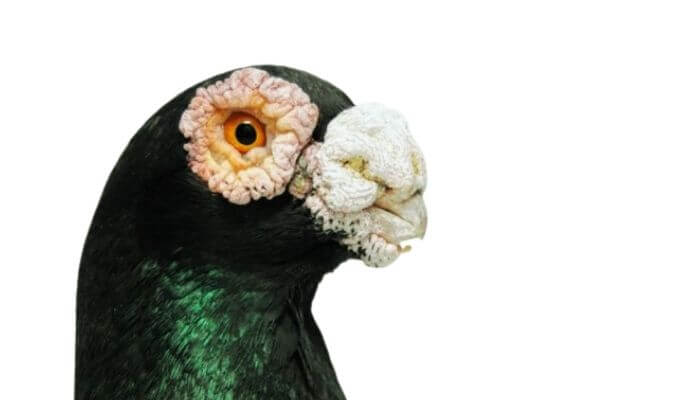Hailing from the United Kingdom, the Barb pigeon is a type of domestic fancy pigeon, the result of many years of selective breeding.
Like every pigeon breed, its line of descendants will trace back to the rock pigeon/dove.

Barb Pigeon Naming Convention
While Barb pigeon is the most common name for this species, it is sometimes extended to English Barb to reflect its origins and in some places, it’s called the Barbary pigeon.
The English epithet is also to distinguish it from other types of barbs which developed in other countries like Spain, Germany and Poland – presumably all with a similar ancestry to the English barb.
Barb Pigeon Origins
The name is thought to have been derived from the original place of origin of the Barbary pigeon. The Barbary Coast was a 15th -19th century name for a region in North Africa.
The Barb(ary) pigeon was known to exist in England in at least the 1500s, if not earlier. It was mentioned by William Shakespeare.
To be exact, it was in a line said by Rosalind in As You Like It, to quote “I will be more jealous of thee than a Barbary cock-pigeon over his hen.” (Act iv, scene 1)
Presumably, it was one of the most common pigeons around at that time (the play was written and performed in 1598-1600) because it is the only type of pigeon known to have been included in a work by Shakespeare.
Old prints show these early birds had single peak crests behind the head, but by Victorian times, better quality birds that didn’t have crests arrived in England via the South of France so selective breeding removed this feature.
Modern barbs do not have crests, but the gene has not been eradicated and documented evidence shows that modern birds can be produced with crests.

The barb is also one of the so-called “Darwin’s Pigeons”.
It is well-known in zoological and related scientific circles that Charles Darwin used pigeons in formulating his theories including those published in “Variation of Animals and Plants Under Domestication.”
He crossed the barb pigeon with fantails and almond tumblers in his experiments/studies.
Barb Pigeon Appearance
The appearance of today’s Barb pigeon was achieved through careful breeding over many generations.
It’s small to medium in size and has a short face. It can grow to just over 33 cm and its weight typically averages about 370 grams.
The most distinctive feature of the Barb pigeon is the large circles of flesh around its eyes, which are usually red in colour. It also has a wrinkled cere (also known as a wattle) that sits over its bill which is short, thick and stout.
The full ceres is a feature of adult birds and can take up to two years to develop.
As its most distinguishing feature, it is one of the exhibition standards and to reflect the various stages of ceres growth there are show birds are usually grouped by age: youngster, yearling and adult, and two years old and above.
Barb pigeons are usually dark grey in colour, often with lighter feathers toward the tail.
They sometimes have iridescent feathers near their neck. Sometimes they are also yellow and lavender feathers mixed in.
In rare cases, they might also be silver or blue. Juvenile Barb pigeons are all white.
Barb Pigeon Behaviour
With bodies like homing pigeons and tumbler pigeons, Barb pigeons are good fliers, and they enjoy the freedom of flight. While the cere may look like they could be obstructive to vision, the bird can see very well.
They are relatively calm birds and make good pets if they are not being raised to show.
Their typical lifespan is 7-10 years.
Barb Breeding
Breeding the barb pigeon is no more difficult than with other pigeon breeds but there is certain care needed that any potential owner should be aware of.
The cere is much more pronounced in males than in females.
The females will grow to a certain size then stop while males’ ceres will grow throughout the bird’s life. This means that extra care and attention needs to be paid to this area.
The cere is an area of crevices and wrinkles that will get warm and moist.
This makes it an area prone to the growth and harboring of bacteria and fungi and therefore needs frequent cleaning to prevent infection.
If you’re looking for a distinctive show pigeon, the Barb is certainly that.
